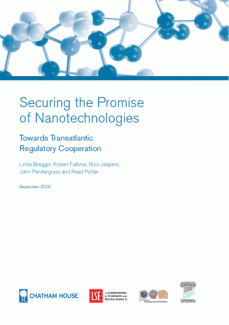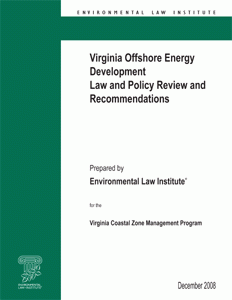Securing the Promise of Nanotechnologies Towards Transatlantic Regulatory Cooperation



Maryland’s population is increasing rapidly while the state continues to lose its agricultural lands. This study explores Maryland’s primary tax measures affecting agriculture, the agricultural use assessment (AUA) and the agricultural land transfer tax (ATT), in order to determine whether these related tax programs could be improved in ways that would encourage farmland protection while continuing to benefit farmers’ bottom lines.

Virginia is facing various forms of energy development activities offshore and in the territorial waters of the Commonwealth. These include possible proposals for wind and wave energy, liquefied natural gas transport, and natural gas drilling on the outer continental shelf, among others. State laws and policies must deal with these activities and their anticipated impacts. Virginia’s Coastal Zone Management Program has provided support for this project by the Environmental Law Institute to examine the law and policy framework in place to deal with potential activities.

The Environmental Protection Agency (EPA) must make key decisions about how to apply the two major end-of-life statutes to nanotechnology waste in order to ensure adequate oversight for these technologies, concludes a new report from the Wilson Center's Project on Emerging Nanotechnologies. However, the report notes that the Agency lacks much of the data on human health and eco-toxicity that form the basis for such determinations, creating some tough challenges ahead in EPA?s decision-making process.

ELI submitted these comments to the House Resources Committee Task Force on Improving/Updating the National Environmental Policy Act (NEPA) that warn the Task Force’s draft recommendations could have the unintended consequences of increasing NEPA litigation and cutting the public out of important federal decision-making.

In 2001, Native Lands published this detailed case study/manual of the participatory mapping it jointly organized in Honduras, Panama, and Bolivia.
This is a detailed account and analysis of the road Native Lands followed to devise and fine-tune the methodology it has been using since 1992. The narrative takes the reader from imperfect, sometimes confused beginnings to a much surer sense of what works and what does not, how community participation can be maximized, what to eliminate, and what to add, strengthen, and bring into focus.

This report discusses the relationship between sewage infrastructure decisions in southwestern Pennsylvania and effects on the urban, suburban, and rural landscape of the region. The study examines ways in which laws and policies relating to sewage infrastructure investment affect four objectives.
This report now provides a follow-up to the Blueprint and reviews the status of various community efforts throughout the Commonwealth to protect natural resources and enhance both economic health and quality of life. Unfortunately, the Virginia Task Force on Sustainable Development concluded its deliberations without making any recommendations about how the Commonwealth can implement sustainable development. Nevertheless, a number of sustainability projects are already under way in Virginia.

Smart growth tools can be useful for small towns and rural communities as well as for major metropolitan areas and rapidly growing localities. States and localities across the country are crafting growth management tools to meet their needs. In most cases, rapidly growing localities and metropolitan areas have felt the strongest need to guide their growth by taking advantage of smart growth tools. Yet, as states put frameworks for smart growth in place, all communities can benefit from regulations and incentives that help them take charge of their future development.